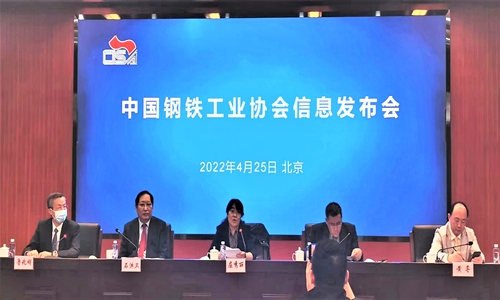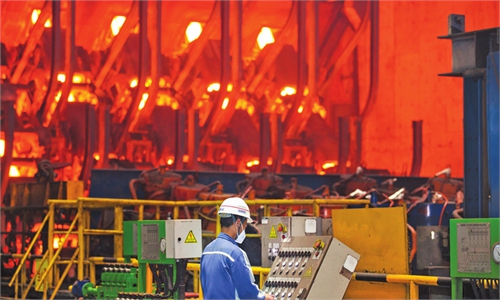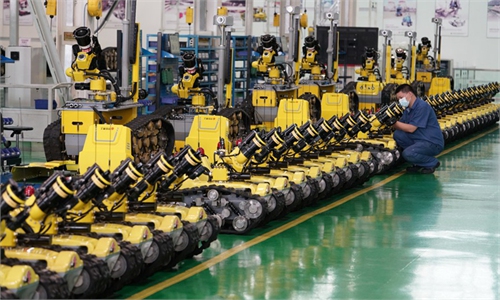
China Iron and Steel Association hosts press conference in Beijing for the first quarter data of steel industry on April 25, 2022. Photo: Yin Yeping/GT
China's steel making contracted in the first quarter amid domestic epidemic flare-ups and the Ukraine crisis, but the sector is likely to improve as the government moves to secure supply chains and increase infrastructure investment, the China Iron and Steel Association (CISA) said on Monday.
In the first quarter, iron production reached 201 million tons, down 11 percent year-on-year, while steel production dropped 10.5 percent to 243 million tons, the CISA said on Monday.
In the first quarter, actual steel consumption of major industries fell by 5 percent, with the construction industry edged down by 7 percent and the manufacturing industry was down by 2 percent, according to the CISA.
Iron ore imports dropped by 5.2 percent to 268 million tons, mirroring curtailed market demand amid the epidemic, especially after the tightened epidemic controls in Tangshan, a major steel production and trade hub in China, accounting for 20-30 percent of national output.
High bulk commodity prices caused by global geopolitical situation like the Ukraine crisis further pressured global supply chains, according to the CISA.
According to the CISA data, at the end of March, the price of imported iron ore reached $158.39 per ton, up 33.2 percent from the beginning of the year.
High prices have squeezed the margins of steelmakers, with the profits of CISA's member companies dropping by 25.8 percent on average.
Despite the uncertainties, industry representatives are confident that the industry will revive as government efforts weigh in.
With the government ramping up efforts to secure supply chains, logistics hurdles caused by highway closures have eased, and progress has been seen as factories are able to run under closed-loop management to contain the epidemic.
To ensure stable market supply, the industry is diversifying sources of supplies by expanding mining both at home and abroad, the CISA said.
Scrap recycling is also being carried out to augment more steel supplies while supporting carbon reduction targets as the industry is going greener.
The biggest driver lies in rising investment in infrastructure and manufacturing as part of the government's efforts to facilitate the industrial growth.
Infrastructure investment maintained rapid growth, up 8.5 percent in the first quarter, 0.4 percentage points higher than in January-February, according to the National Development and Reform Commission on Monday.
The rise in infrastructure investment was conspicuous, and growth is expected to be sustained, industry experts said.
"The consumption of steel in construction takes up to 30 percent of the total…as infrastructure investment is on a rising trend, it certainly gives a boost to the current [stagnant] steel market," Qu Xiuli, deputy head of the CISA, told the Global Times on Monday.
Shi Hongwei, deputy secretary general of the CISA, said that steel consumption has an optimistic future. "Judging from the national economic industrial structure and economic growth rate, this year's steel output and consumption should be basically the same as last year," Shi said.
Global Times


